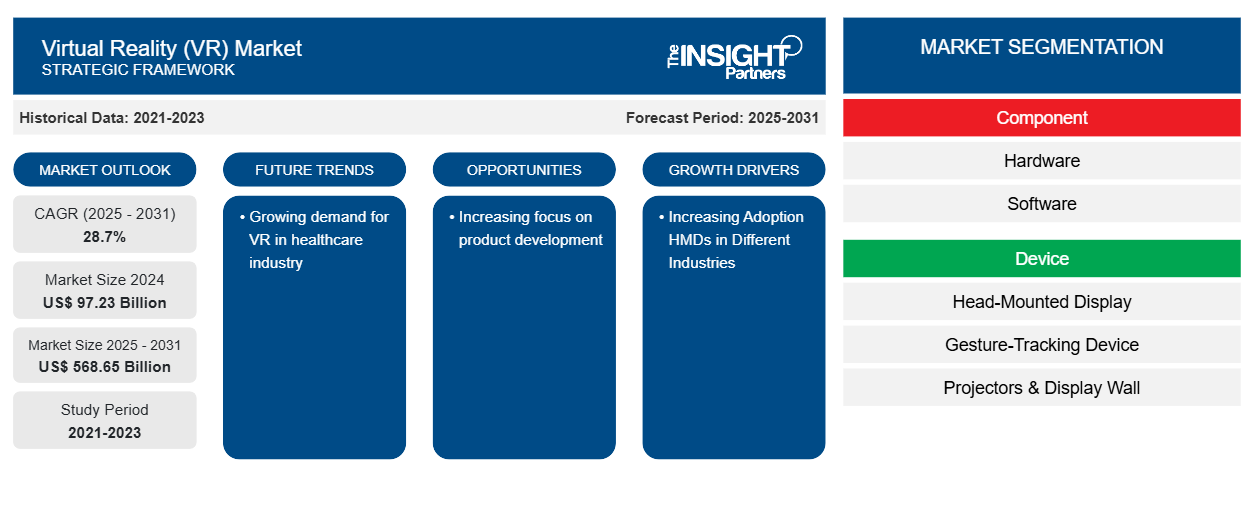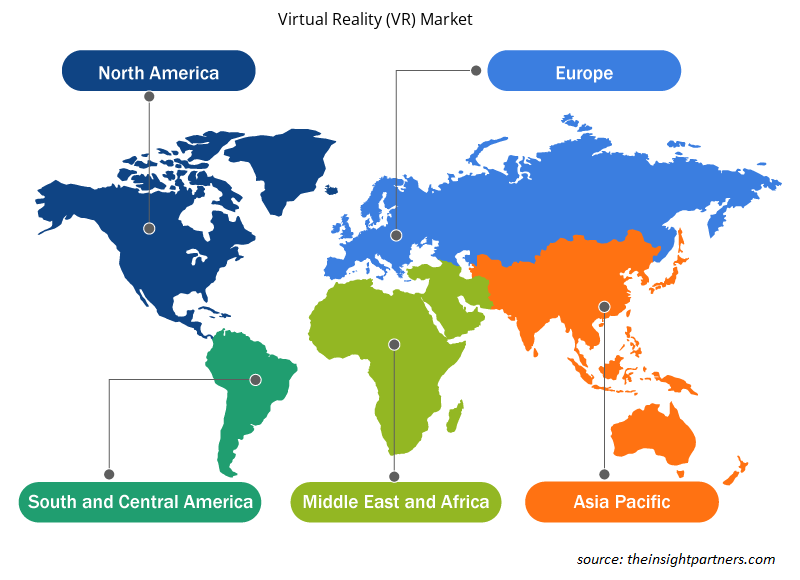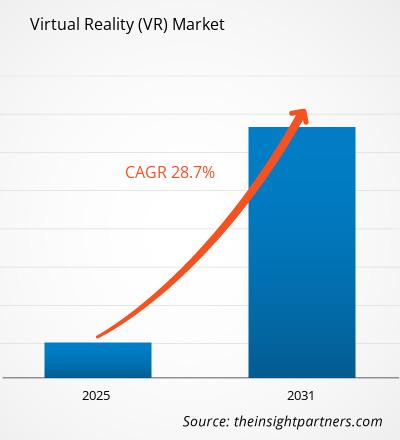The Virtual Reality (VR) Market size is projected to reach US$ 568.65 billion by 2031 from US$ 75.55 billion in 2023. The market is expected to register a CAGR of 28.70% during 2023–2031. Growing demand for VR in the healthcare industry is likely to remain a key trend in the market.
Virtual Reality (VR) Market Analysis
The rising use of Virtual Reality (VR) in instructional training, such as for engineers, defense personnel, field workers, pilots, mechanics, and technicians in several industrial sectors, is boosting the virtual reality (VR) market growth. There has been a rapid growth in virtual reality (VR) gamers globally, expanding the virtual reality (VR) market prospect. According to NewGenApps, a provider of Big Data Analytics, Artificial Intelligence, Machine Learning, and AR/VR solutions, the global user base of AR and VR games is anticipated to rise to 216 million users. It will be valued at US$ 11.6 billion by 2031.The growing adoption of user immersion technology in numerous industries, such as industrial training, education, and healthcare, among others, is anticipated to drive virtual reality (VR) market growth. Moreover, internet penetration in the form of fast 5G networks has positively impacted the acceptance of virtual reality (VR) technology owing to low latency and fast internet connections. The increasing demand for research and training across industries, such as aerospace & defense, education, and automotive, is also driving the virtual reality (VR) market growth.
Virtual Reality (VR) Market Overview
Virtual reality (VR) includes using computer technology fundamentally to generate an artificial environment. Unlike the traditional user interface, virtual reality (VR) places the user inside an experience. With virtual reality (VR) technology, instead of watching a screen in front of them, users are immersed and can cooperate with the 3D environment. With the simulation of numerous senses, such as vision, touch, hearing, and even smell, technology has transformed worldwide. Virtual Reality (VR) reduces the line between the physical and digital world, thereby creating a perception for users of being present in the virtual environment.
Customize This Report To Suit Your Requirement
You will get customization on any report - free of charge - including parts of this report, or country-level analysis, Excel Data pack, as well as avail great offers and discounts for start-ups & universities
Virtual Reality (VR) Market: Strategic Insights

- Get Top Key Market Trends of this report.This FREE sample will include data analysis, ranging from market trends to estimates and forecasts.
You will get customization on any report - free of charge - including parts of this report, or country-level analysis, Excel Data pack, as well as avail great offers and discounts for start-ups & universities
Virtual Reality (VR) Market: Strategic Insights

- Get Top Key Market Trends of this report.This FREE sample will include data analysis, ranging from market trends to estimates and forecasts.
Virtual Reality (VR) Market Drivers and Opportunities
Increasing Adoption of HMDs in Different Industries
Modem-equipped devices are transportable, compact, and easy to operate. They are used to present data in pictorial and graphical formats. These devices need to be compact and simple with high-quality displays. Demand for HUDs, HMDs, and VR projectors has substantially increased across numerous industries, including aerospace & defense, consumer electronics, health and transportation. VR Head-Mounted Displays (HMDs) are becoming more and more prevalent in consumer applications for gaming and entertainment. With the increasing demand and popularity for VR Head-Mounted Displays (HMDs), the principal display manufacturers are developing improved displays for VR Head-Mounted Displays (HMDs). For instance, in June 2023, Kopin, a principal provider of high-performance micro-displays and application-specific optical systems for enterprise, defense, professional and consumer markets, developed a microdisplay specifically for VR Head-Mounted Displays (HMDs).The increasing use of virtual reality (VR) headsets in commercial and consumer applications is boosting its market demand. The growth of HMDs is attributed to the availability of a variety of HMDs, such as hybrid, tethered, and wireless Head-Mounted Displays (HMDs). The HMD devices are used to provide training in various industries, such as engineering, aerospace, research, military, and medicine, as well as to demonstrate a wide range of use cases via interactive features. Further, to bid customers an improved immersive experience, companies are focusing on technological advancements. For instance, in January 2023, Sharp introduced a head-mounted display (HMD) prototype for VR with smartphone connectivity. The HMD devices are used to train individuals in a variety of fields, including aerospace, research, engineering, military, and healthcare, as well as to show an extensive range of application cases using interactive elements. Virtual reality (VR) headset demand is fueled by the technology's expanding usage in both commercial and consumer applications. Therefore, the increasing demand for HMDs is expected to drive the virtual reality (VR) market growth during the forecast period.
Increasing Focus on Product Development
The virtual reality (VR) market is expected to grab growth opportunities presented by rapid technological advancements and increasing demand for immersive digital experiences across sectors such as entertainment, healthcare, education, and manufacturing. As digital transformation initiatives intensify across industries, VR is poised to play a pivotal role in redefining how businesses engage with data, design, and human interaction. Market players are actively investing in the development of next-generation VR solutions, including advanced headsets, smart glasses, and integrated software ecosystems, to strengthen their competitive positioning and broaden their product portfolios. They are strategically launching innovative offerings to accelerate market penetration and meet evolving consumer and enterprise demands.In May 2024, Siemens and Sony Corporation, in collaboration, introduced a cutting-edge solution that integrates the Siemens Xcelerator industrial software suite with Sony’s XR head-mounted display (HMD), the SRH-S1. This device was developed using Siemens' NX software, a core platform leveraged by Sony in the design of its industry-leading products. Similarly, Apple launched the Vision Pro in June 2023, which marked a major milestone in the spatial computing domain. The device redefines user engagement by merging digital content with the physical environment, offering an unparalleled level of interaction while maintaining user awareness of their surroundings. These strategic product introductions reflect a broader trend of convergence between hardware innovation and software sophistication in the VR landscape. With such product launches, market players increasingly focus on enhancing user experience, improving display resolution, reducing latency, and incorporating AI-powered features to drive greater adoption across both consumer and professional applications.
Further, the integration of VR into enterprise workflows—such as virtual prototyping, remote collaboration, immersive training, and simulation—is gaining traction. The expansion beyond gaming and entertainment is expected to significantly broaden the application scope of VR technologies. Thus, continuous investments in product development, strategic partnerships, and cross-industry applications are anticipated to be key growth catalysts for the global virtual reality market in the coming years.
Virtual Reality (VR) Market Report Segmentation Analysis
Key segments that contributed to the derivation of the virtual reality (VR) market analysis are component, device, technology, and application.- Based on component, the virtual reality (VR) market is segmented into hardware and software. The hardware segment is anticipated to witness significant growth in the forecasted period.
- Based on device, the market is segmented into head-mounted display (HMD), gesture-tracking device (GTD), and projectors & display walls (PDW). The head-mounted display (HMD) segment is anticipated to witness significant growth in the forecasted period.
- Based on technology, the market is segmented into semi-fully immersive and non-immersive. The semi & fully immersive segment is anticipated to witness significant growth in the forecasted period.
- Based on application, the market is segmented into aerospace & defense, consumer, commercial, enterprise, healthcare, and others. The consumer segment is anticipated to witness significant growth in the forecasted period.
Virtual Reality (VR) Market Share Analysis by Geography
The geographic scope of the Virtual Reality (VR) Market report is mainly divided into five regions: North America, Asia Pacific, Europe, Middle East & Africa, and South & Central America.North America is anticipated to witness significant growth in the forecasted period. The region has also been an innovator in adopting innovations, which offers North America an advantage over other regions. Additionally, the region has the highest number of startups focusing on bringing innovative virtual reality (VR) technologies to numerous industries. For instance, according to Tracxn Technologies, there are around 951 Virtual Reality (VR) startups in the US. A few of them include Dreamscape, Orbbec, Sandbox VR, and JauntVR.
Virtual Reality (VR) Market Regional Insights
The regional trends and factors influencing the Virtual Reality (VR) Market throughout the forecast period have been thoroughly explained by the analysts at The Insight Partners. This section also discusses Virtual Reality (VR) Market segments and geography across North America, Europe, Asia Pacific, Middle East and Africa, and South and Central America.

- Get the Regional Specific Data for Virtual Reality (VR) Market
Virtual Reality (VR) Market Report Scope
| Report Attribute | Details |
|---|---|
| Market size in 2024 | US$ 97.23 Billion |
| Market Size by 2031 | US$ 568.65 Billion |
| Global CAGR (2025 - 2031) | 28.7% |
| Historical Data | 2021-2023 |
| Forecast period | 2025-2031 |
| Segments Covered |
By Component
|
| Regions and Countries Covered | North America
|
| Market leaders and key company profiles |
Virtual Reality (VR) Market Players Density: Understanding Its Impact on Business Dynamics
The Virtual Reality (VR) Market is growing rapidly, driven by increasing end-user demand due to factors such as evolving consumer preferences, technological advancements, and greater awareness of the product's benefits. As demand rises, businesses are expanding their offerings, innovating to meet consumer needs, and capitalizing on emerging trends, which further fuels market growth.
Market players density refers to the distribution of firms or companies operating within a particular market or industry. It indicates how many competitors (market players) are present in a given market space relative to its size or total market value.
Major Companies operating in the Virtual Reality (VR) Market are:
- Alphabet Inc.
- Barco NV
- CyberGlove Systems, Inc.
- Meta Platforms Inc.
- HTC Corporation
- Microsoft Corporation
Disclaimer: The companies listed above are not ranked in any particular order.

- Get the Virtual Reality (VR) Market top key players overview
Virtual Reality (VR) Market News and Recent Developments
The Virtual Reality (VR) Market is evaluated by gathering qualitative and quantitative data post primary and secondary research, which includes important corporate publications, association data, and databases. A few of the developments in the Virtual Reality (VR) Market are listed below:- Meta Platforms Inc. acquired Within Unlimited, Inc. for its virtual reality (VR) expertise and virtual reality (VR) application called Supernatural. (Source: Meta, Press Release, 2023)
- HTC Corporation launched its novel virtual reality (VR) & augmented reality headset named Vive XR Elite. The new product is equipped with a high-resolution display for an immersive experience. (Source: HTC Corporation, Press Release, 2023)
Virtual Reality (VR) Market Report Coverage and Deliverables
The “Virtual Reality (VR) Market Size and Forecast (2021–2031)” report provides a detailed analysis of the market covering below areas:- Virtual reality (VR) market size and forecast at global, regional, and country levels for all the key market segments covered under the scope
- Virtual reality (VR) market trends as well as market dynamics such as drivers, restraints, and key opportunities
- Detailed PEST/Porter’s Five Forces and SWOT analysis
- Virtual reality (VR) market analysis covering key market trends, global and regional framework, major players, regulations, and recent market developments
- Industry landscape and competition analysis covering market concentration, heat map analysis, prominent players, and recent developments for the Virtual reality (VR) market
- Detailed company profiles
Frequently Asked Questions
Which region dominated the virtual reality (VR) market in 2023?
North America dominated the virtual reality (VR) market in 2023.
What is the expected CAGR of the virtual reality (VR) market?
The global virtual reality (VR) market is estimated to register a CAGR of 28.70% during the forecast period 2023–2031.
What are the driving factors impacting the virtual reality (VR) market?
Increasing adoption of HMDs in different industries is the major factors that propel the global virtual reality (VR) market.
Which are the leading players operating in the virtual reality (VR) market?
The key players holding majority shares in the global virtual reality (VR) market are Alphabet Inc., Barco NV, CyberGlove Systems, Inc., Meta Platforms Inc., HTC Corporation, Microsoft Corporation, Samsung Electronics Co., Ltd., Sensics, Inc., Sixense Enterprises, Inc. (Penumbra, Inc.), and Ultraleap Ltd.
What are the future trends of the virtual reality (VR) market?
Growing demand for VR in the healthcare industry to play a significant role in the global virtual reality (VR) market in the coming years.
What would be the estimated value of the virtual reality (VR) market by 2031?
The global virtual reality (VR) market is expected to reach US$ 568.65 billion by 2031.
- Historical Analysis (2 Years), Base Year, Forecast (7 Years) with CAGR
- PEST and SWOT Analysis
- Market Size Value / Volume - Global, Regional, Country
- Industry and Competitive Landscape
- Excel Dataset
Testimonials
Reason to Buy
- Informed Decision-Making
- Understanding Market Dynamics
- Competitive Analysis
- Identifying Emerging Markets
- Customer Insights
- Market Forecasts
- Risk Mitigation
- Boosting Operational Efficiency
- Strategic Planning
- Investment Justification
- Tracking Industry Innovations
- Aligning with Regulatory Trends
Yes! We provide a free sample of the report, which includes Report Scope (Table of Contents), report structure, and selected insights to help you assess the value of the full report. Please click on the "Download Sample" button or contact us to receive your copy.
Absolutely — analyst assistance is part of the package. You can connect with our analyst post-purchase to clarify report insights, methodology or discuss how the findings apply to your business needs.
Once your order is successfully placed, you will receive a confirmation email along with your invoice.
• For published reports: You’ll receive access to the report within 4–6 working hours via a secured email sent to your email.
• For upcoming reports: Your order will be recorded as a pre-booking. Our team will share the estimated release date and keep you informed of any updates. As soon as the report is published, it will be delivered to your registered email.
We offer customization options to align the report with your specific objectives. Whether you need deeper insights into a particular region, industry segment, competitor analysis, or data cut, our research team can tailor the report accordingly. Please share your requirements with us, and we’ll be happy to provide a customized proposal or scope.
The report is available in either PDF format or as an Excel dataset, depending on the license you choose.
The PDF version provides the full analysis and visuals in a ready-to-read format. The Excel dataset includes all underlying data tables for easy manipulation and further analysis.
Please review the license options at checkout or contact us to confirm which formats are included with your purchase.
Our payment process is fully secure and PCI-DSS compliant.
We use trusted and encrypted payment gateways to ensure that all transactions are protected with industry-standard SSL encryption. Your payment details are never stored on our servers and are handled securely by certified third-party processors.
You can make your purchase with confidence, knowing your personal and financial information is safe with us.
Yes, we do offer special pricing for bulk purchases.
If you're interested in purchasing multiple reports, we’re happy to provide a customized bundle offer or volume-based discount tailored to your needs. Please contact our sales team with the list of reports you’re considering, and we’ll share a personalized quote.
Yes, absolutely.
Our team is available to help you make an informed decision. Whether you have questions about the report’s scope, methodology, customization options, or which license suits you best, we’re here to assist. Please reach out to us at sales@theinsightpartners.com, and one of our representatives will get in touch promptly.
Yes, a billing invoice will be automatically generated and sent to your registered email upon successful completion of your purchase.
If you need the invoice in a specific format or require additional details (such as company name, GST, or VAT information), feel free to contact us, and we’ll be happy to assist.
Yes, certainly.
If you encounter any difficulties accessing or receiving your report, our support team is ready to assist you. Simply reach out to us via email or live chat with your order information, and we’ll ensure the issue is resolved quickly so you can access your report without interruption.















The List of Companies
1. Google, Inc.
2. HTC Corporation
3. Magic Leap
4. Marxent Labs
5. Microsoft Corporation
6. Oculus (Facebook Technologies, LLC)
7. SAMSUNG ELECTRONICS CO., LTD.
8. Sony Corporation
9. Vuzix Corporation
10. WorldViz, Inc.






 Get Free Sample For
Get Free Sample For